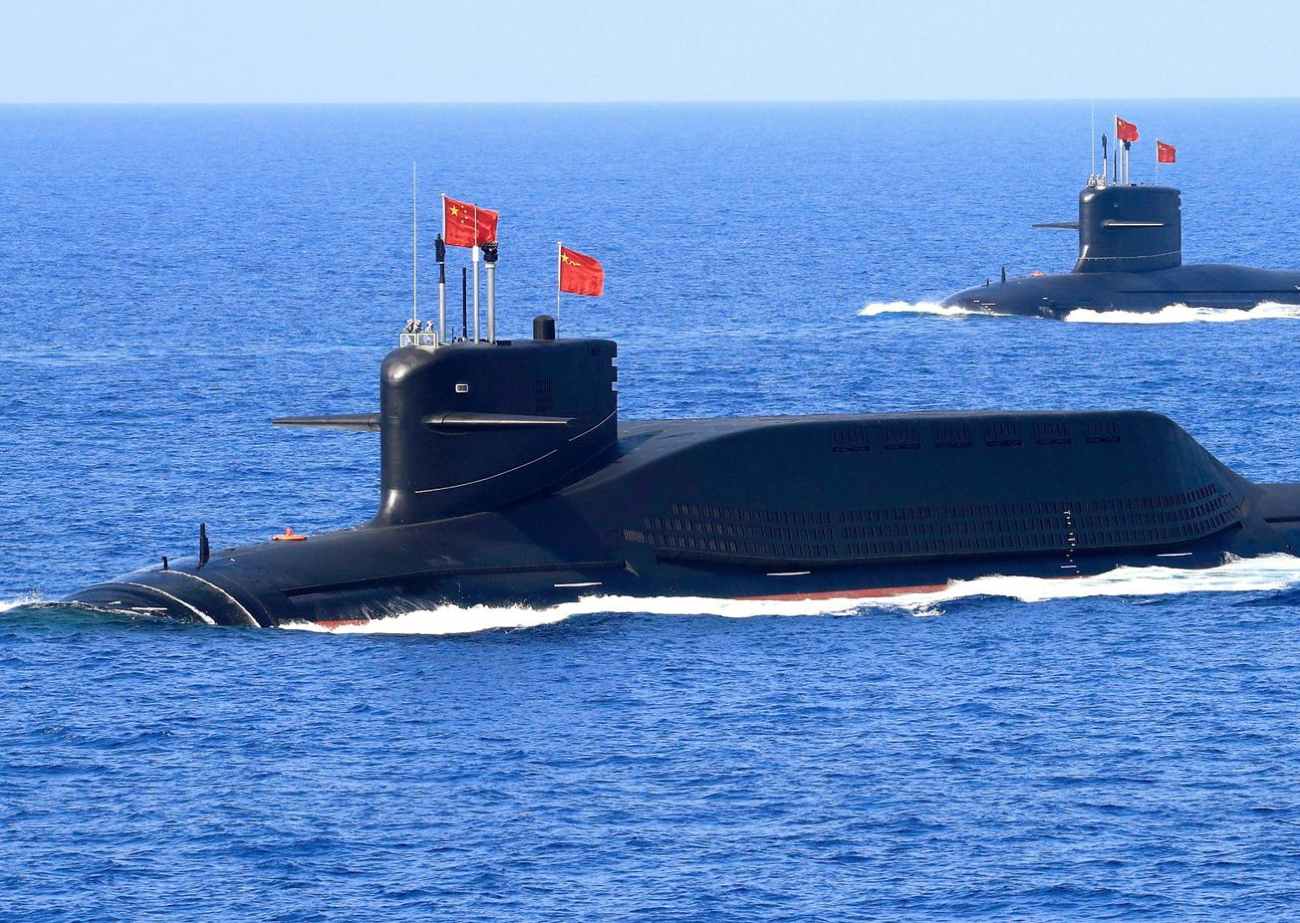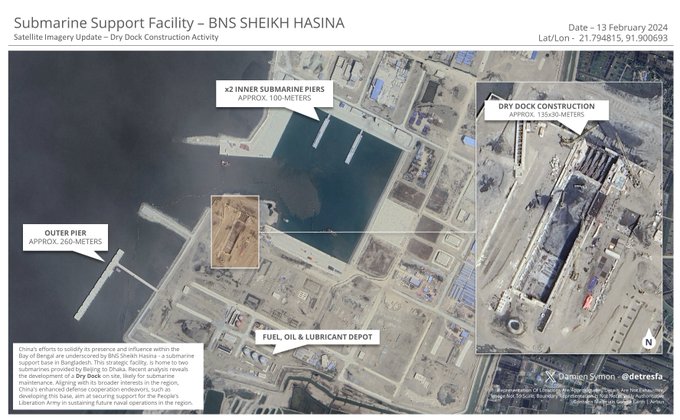Warning To US & India: Chinese Construction Of Naval Bases In Bangladesh & Cambodia Threaten More Tensions

Though China denies extending its sphere of influence by constructing naval bases in Bangladesh and Cambodia, these moves are being viewed with caution in New Delhi and Washington.
China’s assistance in the construction of naval bases in Cambodia (Southeast Asia) and Bangladesh (South Asia) has raised serious security concerns in both regions despite being projected as innocuous projects by Beijing and partner countries.
The suspicion stems from military analysts’ caution over the years that Beijing plans to build a network of military outposts worldwide to expand its influence and challenge regional forces and global superpowers.
Ream Naval Base in Cambodia has been under the scanner for a while. Although the United States has raised concerns and issued warnings regarding Ream’s alleged development as China’s first military facility in the Indo-Pacific region, Cambodia has denied any plans to grant access to the People’s Liberation Army.
The cooperation between the two sides has quietly caught pace. With the presence of at least two warships recently confirmed at the base, it is now widely accepted that the Chinese military continues to access Cambodia’s Ream Naval Base in some capacity, Nikkei Asia reported.

Chinese vessels anchored at the facility first in early December last year. The report observed that the latest sighting on March 20 coincided with American anxieties that China was constructing a facility at the site for its exclusive use.
One of the two vessels, identified as the Chinese Navy corvette Wenshan in photos obtained by Nikkei, is seen sporting the flags of China as well as the Chinese PLA Navy. When the Chinese vessels first visited the base in December, Cambodian Defense Minister Tea Seiha clarified that it was a routine visit. The warships were present at the base until mid-January.
At that time, Collin Koh, a research fellow at the S. Rajaratnam School of International Studies (RSIS) in Singapore, said, “It is a signal that Ream is about to be completed. Of course, it’s still a work in progress for them, but at least now, it has expanded to the point that it could accommodate a foreign navy ship.”
The Cambodian navy has traditionally used the strategically positioned Ream facility, close to the Gulf of Thailand entrance, to get access to the South China Sea and other regions.
This triggered concerns in the West that the expansion of the base with Chinese support could result in the base eventually becoming a Chinese Navy outpost.
Beijing is providing financial support for the base’s upgrades in Cambodia. In February this year, Tom Shugart, a former US Navy submariner and defense analyst, also published satellite images that he obtained from Planet Labs on February 21. The images provide a comprehensive update on China’s progress in building its new base at Ream in Cambodia. The images are dated January 15, 2023.
The images provide an insight into the scale of construction. Although Ream Naval Base is not as big as bases in Japan or the Philippines, it is still a sizeable facility that, according to military watchers, would likely accommodate several big PLA Navy vessels.
Securing access to Ream Naval Base would strengthen and broaden Beijing’s naval operations into the vital Malacca Strait shipping lanes, which are expected to serve as a crucial choke point in the event of a conflict between the US and its regional allies.
The absence of an extensive global network of bases and logistical support limits China’s massive fleet. So, establishing these facilities is essential to Beijing’s objective of creating a fully operational blue-water navy capable of conducting global operations.
With this, Beijing could better project its naval might throughout the Indo-Pacific region and beyond, granting the PLA Navy greater autonomy and ease in conducting operations in international waters.
Although Ream has been under scrutiny for several years now, another naval base constructed by the Chinese is now grabbing eyeballs for its potential to be transformed into a facility that facilitates China’s naval operations. That base is located in the South Asian country of Bangladesh.
China’s Hold On Bangaldesh’s Submarine Base
A renowned OSINT analyst Damien Symon who goes by the username @detresfa_ on Platform X published satellite imagery of Bangladesh’s submarine base built with Chinese assistance on April 1.
“Monitoring imagery of Bangladesh’s China-built submarine base shows the development of a dry dock on site, likely to support submarine maintenance. This enhanced defense cooperation endeavor by China helps Beijing solidify its presence & influence in the region,” he wrote in a post on X.
The recent images showed a dry dock where submarine repairs are done. The length of the dry dock has been roughly estimated to be about 135 meters, and the width about 30 meters.
As soon as the image was posted, it became a talking point among Indian netizens, with some thinking out loud whether the Chinese would use the base for its submarine operations.
These concerns have persisted for some time now. Satellite imagery of the base published in December last year suggested that China had made significant progress on the naval base, and the size of the base indicated that the PLA-Navy would soon gain “logistical access” to the base.
Experts have warned that the Chinese submarines could call and dock at the Bangladesh port for refurbishment and servicing. The experts have labeled this as China’s “submarine diplomacy.”
A previous analysis of satellite imagery of the under-construction naval base in Bangladesh revealed that “Gaining a foothold in the Bay of Bengal would significantly level up the PLA’s ability to operate farther from China’s shores and create new challenges for India, as well as the United States and its allies.”
As part of its military modernization efforts in line with Forces Goal 2030, Bangladesh ordered its first two submarines from China in 2013 for only US$203 million. The attack submarines are Ming-class Type 035G diesel-electric vessels, which were initially put into service by the PLA Navy (PLAN) in 1990.
A year after the submarines were delivered to the country, Poly Technologies, a state-owned defense contractor based in China, reached an agreement to construct a new submarine support station on Bangladesh’s southeast coast for US$1.2 billion.
The 1.75 square kilometer base, named after the current prime minister of Bangladesh, Sheikh Hasina, is known as the BNS Sheikh Hasina Naval Base. PM Hasina declared the base to be “ultra-modern” during its March 2023 inauguration. The ceremony was attended by several Chinese officials, including at least two senior PLA-N officers.

There is evidence that Bangladesh has already stationed its Chinese-origin submarines there. Once completed, the base will be capable of docking six submarines and eight warships simultaneously. However, concerns persist that some of these could be Chinese subs operated by the PLAN, a notion considered detrimental to India’s security.
The US Department of Defense had also previously warned that both Bangladesh and Myanmar were on its list of locations where Beijing was striving to establish overseas military facilities.
Prime Minister Hasina had also noted that the facility could be used as “a service point for ships sailing in the Bay of Bengal” — a potential signal that the PLA-N may one day call at the port there.
While there are few details to get to a conclusive assessment, experts are worried that China is expanding under the cover of assistance for constructing benign and harmless naval facilities.
- Questions and Answers
- Opinion
- Story/Motivational/Inspiring
- Technology
- Art
- Causes
- Crafts
- Dance
- Drinks
- Film/Movie
- Fitness
- Food
- Jogos
- Gardening
- Health
- Início
- Literature
- Music
- Networking
- Outro
- Party
- Religion
- Shopping
- Sports
- Theater
- Wellness
- News
- Culture
- War machines and policy



